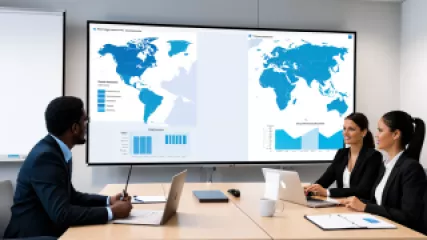10 Best Virtual Conflict Resolution Tools for Effective Conflict Management
10 Best Virtual Conflict Resolution Tools for Effective Conflict Management
In today's increasingly remote and digital world, the need for effective conflict management solutions has never been more pressing. Whether your team is spread across the globe or you're navigating complex personal relationships, having the right virtual tools in your arsenal can make all the difference in resolving conflicts productively and preserving crucial connections.
In this comprehensive list, we'll explore 10 of the best virtual conflict resolution tools that can help you and your team, colleagues, or loved ones navigate challenging situations with grace and efficiency. From interactive whiteboards to online mediation platforms, these innovative solutions are designed to facilitate open communication, foster mutual understanding, and guide you towards effective, win-win resolutions.
1. Zoom Breakout Rooms
Zoom, the ubiquitous video conferencing platform, offers a powerful feature for conflict resolution – Breakout Rooms. This virtual tool allows you to split your meeting participants into smaller, private groups, enabling more focused discussions and the opportunity for individuals to address issues in a more intimate setting.
By leveraging Zoom's Breakout Rooms, you can create a safe space for parties involved in a conflict to express their perspectives, explore underlying issues, and work towards a resolution without the entire group present. This can be particularly useful for sensitive topics or when emotions are running high, as it provides a more controlled environment for productive dialogue.
Moreover, the Breakout Room feature allows the host to move between the rooms, providing guidance, mediation, or simply observing the discussions as needed. This level of flexibility and control can be invaluable in navigating complex conflict resolution scenarios.
2. Miro Interactive Whiteboard
Miro is a cloud-based, collaborative whiteboard platform that has become an indispensable tool for remote teams and individuals alike. Its versatility makes it an excellent choice for virtual conflict resolution, as it allows participants to visually represent and address the issues at hand.
With Miro, you can create customizable templates for conflict management sessions, including frameworks for root cause analysis, stakeholder mapping, and solution brainstorming. Participants can contribute ideas, draw diagrams, and organize their thoughts in real-time, fostering a shared understanding of the problem and potential paths forward.
The platform's intuitive interface and extensive suite of collaboration tools, such as sticky notes, text boxes, and drawing tools, empower participants to actively engage in the conflict resolution process, regardless of their physical location. This visual approach can be particularly effective in breaking down complex issues and aligning all stakeholders on a common understanding.
3. Asana for Collaborative Task Management
While Asana is primarily known as a project management tool, its capabilities extend far beyond that. Asana can also be an invaluable resource for virtual conflict resolution, particularly when it comes to managing tasks and responsibilities associated with resolving a conflict.
By creating dedicated Asana projects or boards for conflict resolution, you can assign specific tasks to involved parties, set deadlines, and track progress towards a resolution. This collaborative approach helps ensure that all stakeholders are aligned on the steps being taken, and that no crucial tasks fall through the cracks.
Furthermore, Asana's commenting and communication features allow participants to discuss issues, share feedback, and document the conflict resolution process in a centralized location. This level of transparency and accountability can be instrumental in building trust and sustaining a productive dialogue throughout the conflict resolution journey.
4. Gather.town for Immersive Virtual Collaboration
Gather.town is a unique virtual platform that offers an immersive, game-like experience for remote collaboration and conflict resolution. By creating customizable virtual spaces, Gather.town allows participants to move around, interact with each other, and even engage in private conversations – all while maintaining a sense of spatial awareness and social presence.
This environment can be particularly beneficial for conflict resolution scenarios, as it can help recreate the sense of physicality and proximity that is often lost in traditional video conferencing. Participants can move their avatars to private corners for sensitive discussions, or gather in larger groups for collective brainstorming and problem-solving.
The platform's built-in features, such as shared whiteboards, file sharing, and screen-sharing, further enhance the collaborative experience, making it easier for participants to visualize, document, and work towards a resolution together.
5. Slido for Interactive Q&A and Polling
Slido is a powerful interactive tool that can be incredibly useful in the context of virtual conflict resolution. By incorporating Slido into your conflict management sessions, you can facilitate more engaging and inclusive dialogues, allowing all participants to contribute their perspectives and ideas.
Slido's features, such as live Q&A, polls, and surveys, enable you to gather real-time feedback, gauge the pulse of the group, and identify areas of consensus or disagreement. This information can be invaluable in guiding the conflict resolution process, as it helps ensure that all voices are heard and that the proposed solutions address the core concerns of the stakeholders involved.
Moreover, Slido's anonymity options can encourage more open and honest participation, particularly when discussing sensitive or controversial topics. This can create a safer space for participants to share their true feelings and concerns without fear of retaliation or judgment.
6. Klaxoon for Interactive Workshops and Brainstorming
Klaxoon is a comprehensive suite of virtual collaboration tools that can be instrumental in facilitating effective conflict resolution. With its interactive workshops, real-time brainstorming features, and seamless integration with video conferencing platforms, Klaxoon empowers participants to actively engage in the conflict resolution process.
One of the standout features of Klaxoon is its ability to create customizable workshops tailored to the specific needs of a conflict resolution session. These workshops can include structured activities, such as root cause analysis, solution ideation, and action planning, all within a visually appealing and intuitive digital environment.
Klaxoon's collaborative features, such as virtual sticky notes, voting mechanisms, and timed activities, help ensure that all participants have an equal opportunity to contribute their ideas and reach a consensus. This level of engagement and interactivity can be crucial in breaking down complex issues and fostering a shared understanding among the parties involved.
7. Microsoft Teams for Integrated Collaboration
Microsoft Teams, the popular collaboration platform, can also be leveraged as a valuable tool for virtual conflict resolution. With its robust suite of communication, file-sharing, and project management features, Teams provides a centralized hub for teams to navigate and resolve conflicts effectively.
The platform's video conferencing capabilities allow for face-to-face discussions, while its chat functions enable ongoing, asynchronous communication. Teams also integrates seamlessly with other Microsoft applications, such as OneNote and SharePoint, allowing participants to collaboratively document the conflict resolution process and access relevant information and resources.
Additionally, Teams' channel-based structure can be useful in organizing conflict resolution efforts, with dedicated channels for each conflict or issue. This level of organization and transparency can help ensure that all stakeholders are informed and engaged throughout the process.
8. Zoom Whiteboard for Visual Collaboration
Building on the versatility of the Zoom platform, the Zoom Whiteboard feature offers a powerful tool for virtual conflict resolution. This interactive whiteboard allows participants to collaborate in real-time, using a variety of drawing, annotation, and text tools to visualize and address the issues at hand.
The Zoom Whiteboard's intuitive interface makes it easy for participants to contribute their ideas, create diagrams, and map out potential solutions. This visual approach can be particularly effective in breaking down complex conflicts and fostering a shared understanding among the stakeholders involved.
Moreover, the Zoom Whiteboard seamlessly integrates with the platform's video conferencing capabilities, enabling participants to discuss and interact with the content on the whiteboard in a synchronous and engaging manner. This can be invaluable in remote conflict resolution scenarios, where the ability to collaborate visually can make a significant difference in the outcomes.
9. Loom for Asynchronous Video Messaging
Loom, the popular video messaging platform, can also play a valuable role in virtual conflict resolution. By allowing participants to record and share short, asynchronous video messages, Loom can facilitate more thoughtful and reflective dialogue, particularly when scheduling synchronous meetings is challenging.
In the context of conflict resolution, Loom can be used to share personal perspectives, express concerns, or propose solutions without the need for real-time interaction. This can be especially useful when emotions are running high, as it provides participants with the time and space to articulate their thoughts and feelings more effectively.
Additionally, Loom's ability to capture screen recordings and annotations can be leveraged to document the conflict resolution process, create visual aids, and ensure that all stakeholders have access to the same information, even when they are unable to attend live meetings.
10. Conflict Resolution Chatbots
In the rapidly evolving landscape of virtual tools, even artificial intelligence is making its mark in the realm of conflict resolution. Conflict resolution chatbots are emerging as innovative solutions that can provide personalized guidance and support to individuals or teams navigating challenging interpersonal situations.
These AI-powered chatbots are designed to ask probing questions, provide empathetic listening, and offer tailored suggestions for de-escalating conflicts, improving communication, and finding mutually beneficial solutions. By leveraging natural language processing and machine learning algorithms, conflict resolution chatbots can offer a level of personalization and accessibility that can complement human-led conflict resolution efforts.
While these chatbots should not be seen as a replacement for professional conflict management services, they can serve as a valuable resource for individuals or teams seeking immediate support, self-guided exercises, or additional learning opportunities related to effective conflict resolution strategies.
Conclusion
In today's increasingly digital world, the need for effective virtual conflict resolution tools has never been more crucial. The 10 solutions outlined in this article offer a diverse range of capabilities, from interactive whiteboards and collaborative task management to specialized chatbots and immersive virtual environments.
By incorporating these innovative tools into your conflict management toolkit, you can empower your team, colleagues, or loved ones to navigate complex interpersonal challenges with greater ease, efficiency, and emotional intelligence. Whether you're seeking to resolve professional disputes, mend personal relationships, or foster a more harmonious remote work culture, these virtual conflict resolution tools can be instrumental in helping you achieve your goals.
Remember, effective conflict management is not just about resolving issues – it's about preserving and strengthening the relationships that matter most. By leveraging the power of technology and embracing a collaborative, solution-focused mindset, you can transform conflicts into opportunities for growth, understanding, and lasting positive change.
As the world continues to evolve, the need for adaptable and inclusive conflict resolution strategies will only become more pressing. By equipping yourself and your team with the right virtual tools, you can navigate the challenges of the modern landscape with confidence, empathy, and a commitment to mutually beneficial outcomes.
So, whether you're a remote team leader, a conflict resolution professional, or simply someone navigating the complexities of interpersonal relationships, consider exploring these 10 innovative virtual solutions. Invest in the tools that can empower you to manage conflicts effectively, build stronger connections, and create a more harmonious world – one virtual interaction at a time.






